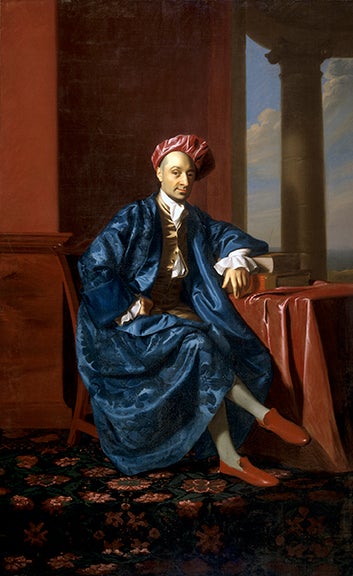Adams’s mother was a Boylston, first cousin to this Boston merchant. However, Adams visited Boylston’s home only after becoming a rising young lawyer from Braintree, in Boston for court business and a whirl of political conversations.
On 14 January, for instance, Adams dined at town clerk William Cooper’s house with Thomas Cushing, speaker of the house; William Story, an Admiralty Court official; and John Boylston, yet another cousin on his mother’s side.
Adams recorded in his diary:
Boylstone, affecting a Phylosophical Indifference about Dress, Furniture, Entertainments &c., laughed at the affectation of nicely distinguishing Tastes, such as the several Degrees of Sweet till you come up to the first degree of bitter, laughed at the great Expences for Furniture, as Nick Boylstones Carpetts, Tables, Chairs, Glasses, Beds &c. which Cooper said were the richest in N. America.—The highest Taste and newest Fashion, would soon flatten and grow old.The next evening, Adams met with “the Sons of Liberty, at their own Apartment in Hanover Square, near the Tree of Liberty.” This was the group also called the “Loyall Nine,” principal organizers of the protests that had negated the Stamp Act the year before. They were preparing to celebrate the law’s expected repeal.
Finally came this diary entry:
Thurdsday. Jany. 16th. 1766.Even though those luxurious furnishings might “soon flatten and grow old,” they awed the young country lawyer.
Dined at Mr. Nick Boylstones, with the two Mr. Boylstones [Nicholas and his brother Thomas, probably], two Mr. [James and Isaac?] Smiths, Mr. [Benjamin] Hallowell and the Ladies [the Boylstons’ sister Mary Hallowell and possibly James Smith’s wife, Elizabeth]. An elegant Dinner indeed!
Went over the House to view the Furniture, which alone cost a thousand Pounds sterling. A Seat it is for a noble Man, a Prince. The Turkey Carpets, the painted Hangings, the Marble Tables, the rich Beds with crimson Damask Curtains and Counterpins, the beautiful Chimny Clock, the Spacious Garden, are the most magnificent of any Thing I have ever seen.
TOMORROW: Dinner conversation.
[The image above shows how John Singleton Copley remade his portrait of Nicholas Boylston, shown yesterday. Harvard College commissioned this copy in 1773, after the merchant had died and left money for a professorship. To match other paintings Copley had made for the college, he turned his original composition into a taller, full-figure portrait. As a result, Boylston was immortalized in honking big red slippers.]

No comments:
Post a Comment